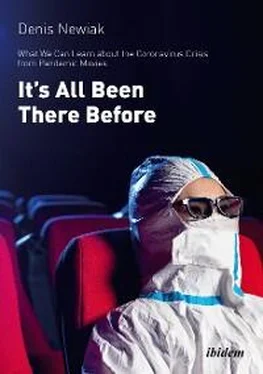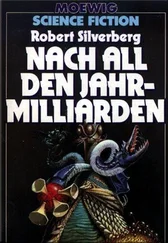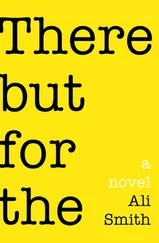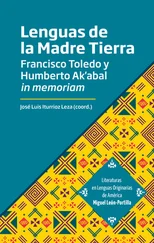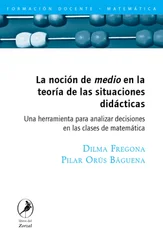The same can be said about the fictional pandemic scenarios. They surprisingly early on recognized one of the most important challenges of life in late modernity, brought it into the general discourse and provided it with its own connotations. Although the spread of Covid-19 was not associated with an anarchic zombie apocalypse, as we know it from The Walking Dead , television viewers and casual cineasts alike intuitively understand very well that, behind the superficially banal phenomena of popular culture, which outwardly serve above all to amuse and distract, there is a multilayered, complex thicket of meanings that cannot be easily unraveled. Everybody needs to somehow make it through the dense undergrowth of exaggerations and stereotyping, production calculations and ingratiation with target groups, simplification and pomposity – but after that, we can see the potential of these important art forms of late modernism to point out social trends and imbalances with a critical gesture, long before they become part of public and political discussion.
In the case of pandemic films, which has been celebrating a sustained boom for several years now, one could almost speak of a prophetic potential of the medium: film and television have not only warned of the devastating consequences of such a scenario by overthematizing a possible dangerous outbreak of a new type of infectious disease. They have also taken a stand and, in some cases, made astonishingly concrete recommendations for action on how to orient oneself in unknown threatening situations, i.e. how to deal with the short, medium and longterm consequences. Of course, entertainment formats such as Designated Survivor or sophisticated dramas such as Children of Men do not have any universally applicable ‘patent solutions’ for all the problems associated with pandemics that could simply be transferred into everyday life, and that is neither their task nor feasible. However, film and television, hidden among their aesthetically encoded appearances, contain a vast store of knowledge that can be harnessed to better manage challenging situations. But cinematic phenomena as art forms do not directly release this knowledge, and it can even be scattered between narrative-aesthetic contradictions, conflicting interests and problematic connotations, an attentive and critical reading, analysis and contextualization is necessary, since staging, dramaturgy and figure drawing make attributions that first have to be decoded.
Typically, this ‘decryption’ happens quite naturally at the moment of the film and television experience. This compact book tries to ‘speed up’ this complex and time-consuming individual process with the goal to make the arts’ important knowledge useful for the current situation as well as for possible future pandemic crises: What kind of scenarios regarding the causes, developments, and consequences of pandemics does the genre develop? Which fields of action and conflict emerge and how are they evaluated? And what kind of concrete behavioral proposals do film and television make to meet the challenges of a pandemic? Film and television do not reveal this valuable information on their own: as experienced cinemagoers and television viewers, we have learned to extract from filmic experiences those behavioral fragments that seem potentially meaningful and useful for everyday life. From childhood on, we intuitively know how to do that. As a ‘watching’ society, we understand the fictional scenarios as offers (which we always may refuse) of how to behave appropriately in a society. Anyone who has watched a few apocalypse films may well admit that the official recommenddation from national disaster control and civil protection agencies to keep a food supply for at least two weeks can at least not be harmful. At the same time, every art form thrives on exaggerations, inner contradictions, and conscious distortions in order to condense complex relationships, but also to maintain our reception interest through tension arcs and the production of affect, which promises both immaterial and commercial success. The film and television industry, like any other business, is subject to certain materialistic and ideological constraints which can affect production conditions and narratives and thus lead to distortions of what one hopes to take from a film or television series as a supposed ‘meaning.’ Filmmakers and television makers are not free from narcissistic interests, economic pressures, and human errors – but the collective mode of production, the effort to attract a large interested (and thus potentially paying) audience, and a healthy degree of shyness in the face of possible scandals caused by embarrassing mistakes, creates an astonishing trustworthiness of this art form – and we have been proving our trust in films for more than a century now. By not simply accepting and imitating what we see without question as a supposed ‘truth,’ but rather understanding it as a concrete construction of possible realities, we have come to know cinema and television as two of many sources that can help us recognize and work on the most pressing contemporary questions and find answers for a good life in the risky, opaque and lonely 21st century.
The present book is intended to enable interested readers to become acquainted with thematizations, staging, and recommendations in pandemic films and series, so that they can use them for their own conscious, reflected, and considered actions during the current health and social crisis, without having to deal with all the subtleties of media, film, and television theory or having necessarily seen all the works discussed in this book. At the same time, the offered interpretations can lend a new dimension of meaning to an early reception experience and further enrich one’s own cinematic wealth of experience. Since the urgent social, political, and economic issues raised by the current Covid-19 pandemic are likely to remain in the limelight for some time to come, this book is intended to contribute to initiating and conducting a dialogue on how we as a global community can jointly master the challenges of such health and social crises, rather too early than too late. The following text was originally intended for publication in a highly specialized circle of media experts. I apologize to the reader that this resulted in the jargon and structure of the text, which was tolerated in order to make the findings quickly accessible through a speedy publication. At the same time, I would ask my colleagues in the field to kindly overlook the fact that this is not a film and television science treatise in the conventional sense, but that, in view of the acute need, the opportunity should be taken to refunction the academic toolbox in such a way that possible findings that could be relevant and helpful here and now can be discussed in good time.
By opening up the work to a generally interested group of readers, I hope to be able to make at least a small contribution to ensuring that the rich treasure of knowledge from film and television plays an even greater role in everyday crisis management. The book is aimed not only at cineastes, ‘series junkies’ and those who might want to become one after reading it, but also at decisionmakers at all political levels, who are expected to make prudent decisions under largely unknown conditions. As an extract of cinematic pandemic knowledge (especially in the form of short summaries of the core statements for each paragraph), the book is intended to help people, who have assumed responsibility for others, to quickly extract the movies’ and TV shows’ most important recommendations for action from the material. I hope that this book may help reflect and debate the media’s ideas critically, assess them in all their conceivable consequences, and ultimately perhaps even allow them to influence political decisionmaking. It is a matter close to my heart – especially in view of the performance strengths and limitations of the qualitative humanities, which I am aware of – to actively participate in the urgent and important discourse on the ‘what now?’ in the Covid-19. However, my aim is not to take a stand for or against a particular measure, but rather to show how film and television would position themselves on a concrete question with which we are currently confronted. Every hermeneuttic reading and analysis of a work of art, even with the strictest methodological procedures, always has something subjective attached, so that one should be committed to and fairly argue about the resulting findings, the present condensed study strives at all times to maintain a critical distance to its object of investigation. Nevertheless, we should be aware that precisely in a crisis situation, in which important modern achievements are called into question by some, in which great trials await the liberal lifestyle and earlier errors threaten to return, the commitment to the values of a free, peaceful, democratic and dignified way of life must not fall victim to a misunderstood commitment to academic neutrality or to certain current speaking habits.
Читать дальше
